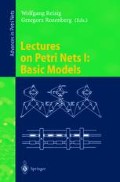Abstract
A collection of 10 “rules of thumb” is presented that helps to determine the decidability and complexity of a large number of Petri net problems.
Work partially supported by the Sonderforschungsbereich 342 “Werkzeuge und Methoden für die Nutzung paralleler Rechnerarchitekturen”.
Preview
Unable to display preview. Download preview PDF.
References
J.L. Balcázar, J. Diaz, and J. Gabarró. Structural Complexity I, volume 11 of Monographs in theoretical Computer Science. Springer-Verlag, 1988.
A. Cheng, J. Esparza, and J. Palsberg. Complexity Results for 1-safe Nets. Theoretical Computer Science, 147:117–136, 1995.
F. Commoner, A. W. Holt, S. Even, and A. Pnueli. Marked Directed Graphs. Journal of Computer and System Sciences, 5:511–523, 1971.
M. Dam. Fixpoints of Biichi automata. In Proceedings of the 12th International Conference of Foundations of Software Technology and Theoretical Computer Science, volume 652 of Lecture Notes in Computer Science, pages 39–50, 1992, Also: LFCS Report, ECS-LFCS-92-224, University of Edinburgh.
J. Desel and J. Esparza. Free-choice Petri Nets, volume 40 of Cambridge Tracts in Theoretical Computer Science. Cambridge University Press, 1995.
E. A. Emerson. Temporal and Modal Logic. In Handbook of Theoretical Computer Science Volume B, pages 995–1027, 1990.
J. Esparza. Model Checking Using Net Unfoldings. Science of Computer Programming, 23:151–195, 1994.
J. Esparza. Reachability in Live and Safe Free-Choice Petri Nets is NP-Complete. Technical Report SFB-Bericht Nr. 342/12/96 A, Technische Universitiit Miinchen, 1996. To appear in Theoretical Computer Science.
J. Esparza. Decidability of Model-Checking for Infinite-State Concurrent Systems. Acta Informatica, 34:85–107, 1997.
J. Esparza and M. Nielsen. Decidability Issues for Petri Nets — a Survey In. Bulletin of the EATCS, volume 52, pages 245–262, 1994 Also: Journal of Information Processing and Cybernetics 30(3):143-160, 1995.
Formal methodspage of the WWW Virtual Library at http://www.comlab.ox.ac.uk/archive/formal-methods.html#notations.
M. R. Garey and D. S. Johnson. Computers and Intractability: A Guide to the Theory of NP-completeness. Freeman, 1979.
H. J. Genrich and K. Lautenbach. Synchronisationsgraphen. Acta Informatica, 2:143–161, 1973.
P. Habermehl. On the Complexity of the Linear-Time Mu-Calculus for Petri Nets. In P. Azéma and G. Balbo, editors, Application and Theory of Petri Nets, volume 1248 of Lecture Notes in Computer Science, pages 102–116. Springer-Verlag, 1997.
M. H. T. Hack. Analysis of Production Schemata by Petri Nets. M.s. thesis, Cambridge, Mass.: MIT, Dept. Electronical Engineering, 1972.
J. E. Hopcroft and J. Ullman. Introduction to Automata Theory, Languages and Computation. Additon-Wesley, 1979.
R. R. Howell and L. Rosier. On Questions of Fairness and Temporal Logic for Conflict-free Petri Nets. In G. Rozenberg, editor, Advances in Petri Nets, volume 340 of Lecture Notes in Computer Science, pages 200–220, 1988.
R. R. Howell and L. E. Rosier. An O(n 1.5) Algorithm to Decide Boundedness for Conflict-free Vector Replacement Systems. Information Processing Letters, 25(1):27–33, 1987.
R. R. Howell and L. E. Rosier. Problems Concerning Fairness and Temporal Logic for Conflict-free Petri Nets. Theoretical Computer Science, 64:305–329, 1989.
R. R. Howell, L. E. Rosier, and H. Yen. A Taxonomy of Fairness and Temporal Logic Problems for Petri Nets. Theoretical Computer Science, 82:341–372, 1991.
P. Jančar. All Action-based Behavioural Equivalences are Undecidable for Labelled Petri Nets. Bulletin of EATCS, 56:86–88, 1995.
P. Jančar. Undecidability of Bisimilarity for Petri Nets and Some Related Problems. Theoretical Computer Science, 148:281–301, 1995.
L. Jategaonkar and A. Meyer. Deciding True Concurrency Equivalences on Safe, Finite Nets. Theoretical Computer Science, 154(1):107–143, 1996.
N. D. Jones, L. H. Landweber, and Y. E. Lien. Complexity of Some Problems in Petri Nets. Theoretical Computer Science, 4:277–299, 1977.
S.R. Kosaraju. Decidability of Reachability in Vector Addition Systems. In 14th Annual ACM Symposium on Theory of Computing, pages 267–281, San Francisco, 1982.
L. Lamport. The Mutual Exclusion Problem. Part II — Statement and Solutions. Journal of the ACM, 33(2), 1986.
R. Lipton. The Reachability Problem Requires Exponential Space. Technical Report 62, Yale University, 1976.
E. W. Mayr. An Algorithm for the General Petri Net Reachability Problem. SIAM Journal on Computing, 13:441–460, 1984.
E.W. Mayr and A.R. Meyer. The Complexity of the Word Problems for Commutative Semigroups and Polynomial Ideals. Advances in Mathematics, 46:305–329, 1982.
WWW page on Petri net tools at http://www.daimi.aau.dk/petrinets/tools/.
A. Rabinovich. Complexity of Equivalence Problems for Concurrent Systems of Finite Agents. Information and Computation, 127(2):164–185, 1997.
C. Rackoff. The Covering and Boundedness Problem for Vector Addition Systems. Theoretical Computer Science, 6:223–231, 1978.
P. Starke. Analyse von Petri-Netz-Modellen. Teubner, 1990.
C. Stirling. Bisimulation, Model Checking and Other Games. Notes for Mathfit instructional meeting on games and computation, Edinburgh, June 1977. Available at http://www.dcs.ed.ac.uk/home/cps/.
A. Valmari. State Space Generation: Efficiency and Practicality. Phd thesis, Tampere University of Technology, 1988.
R. J. van Glabbeek. The Linear Time-Branching Time Spectrum. In Proceedings of CONCUR '90, volume 458 of Lecture Notes in Computer Science, pages 278–297, 1990.
M. Vardi. An Automata-Theoretic Approach to Linear temporal Logic. In Logics for Concurrency: Structure versus Automata, volume 1043 of Lecture Notes in Computer Science, pages 238–265, 1996.
H. C. Yen. A Unified Approach for Deciding the Existence of Certain Petri Nets Paths. Information and Computation, 96(1):119–137, 1992.
H. C. Yen. A Polynomial Time Algorithm to Decide Pairwise Concurrency of Transitions for 1-Bounded Conflict Free Petri Nets. Information Processing Letters, 38:71–76, 1991.
Author information
Authors and Affiliations
Editor information
Rights and permissions
Copyright information
© 1998 Springer-Verlag Berlin Heidelberg
About this chapter
Cite this chapter
Esparza, J. (1998). Decidability and complexity of Petri net problems — An introduction. In: Reisig, W., Rozenberg, G. (eds) Lectures on Petri Nets I: Basic Models. ACPN 1996. Lecture Notes in Computer Science, vol 1491. Springer, Berlin, Heidelberg. https://doi.org/10.1007/3-540-65306-6_20
Download citation
DOI: https://doi.org/10.1007/3-540-65306-6_20
Published:
Publisher Name: Springer, Berlin, Heidelberg
Print ISBN: 978-3-540-65306-6
Online ISBN: 978-3-540-49442-3
eBook Packages: Springer Book Archive

